|
|
 |


May/June
2002
 Pickle
Champ Pickle
Champ
Matlacha resident Champ Planét’s pickles, mango chutney, pickled
garlic, pickled beets with Vidalia onions, pickled pineapple, and salsa
are eliciting rave reviews throughout North America. At least by folks
lucky enough to get hold of some.
Pickling has long been a part of Planét’s
life. While he was growing up in Miami, his parents sent him to visit
his French grandparents and his Czech grandmother in New York State during
summers. “My Czech grandmother would do pickling and sell the pickles.
She had been a young widow. She grew her own produce or went to farms
and always stressed to me about the freshness of vegetables and fruit,”
Planét explains.
“I started making pickles for sale 18 years
ago when my daughter was three months old,” says Planét, who
was in the Army for 23 years and retired as a chief warrant officer. “I’d
visit picklers wherever I was stationed. A lot of people took time to
teach me. I learned to make pickled pineapple in Hawaii.”
He started his gourmet pickling business four
years ago, when he moved to Matlacha from the East Coast of Florida. “I
have two historic homes with an old garage that I turned into a pickling
kitchen. It’s certified by the Department of Agriculture.”
He started making mango chutney, which contains eight kinds of Pine Island
mangos, just last summer, but it already is in high demand. “I bought
mango chutney from different companies from all over the world and none
tasted to me what my idea of mango chutney should be,” he explains.
His customers include gourmet stores in New Mexico;
Colorado; Wyoming; in Seattle; and British Columbia, where his daughter
lives. “They buy them because they know there are no chemical preservatives
or dyes.” Except for his garlic, which comes from Gilroy, California,
all Planét’s produce is from local farms.
– Libby Grimm
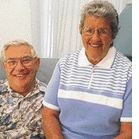 Happy
Campers Happy
Campers
When two people like Armand and Beverly Ball are united in marriage, each
partner must be prepared to adapt his or her lifestyle. For Bev, whose
husband was chief executive of the American Camping Association, that
meant consigning three months of her life each year for many years to
living in a remote cabin while her husband trained youth camp leaders.
“At the end of three months I was ready to
go home,” says Bev, who ran the association’s publications department.
Now that the Balls have coauthored a college textbook on camp management
and are semiretired, the tables have turned. Bev is coordinator of the
Sanibel-Captiva Conser-vation Foundation’s sea turtle program, with
more than 100 volunteers. “Towards the end of the turtle season,
you want the turtles to go home, too,” jokes Armand.
From Russia to Malaysia to Bermuda to Minnesota,
they have journeyed all over the world for their work. But after deciding
that they could provide camp management consultations from anywhere, they
moved to Sanibel in the 1980s.
Over the years, Bev has donated much of her time
to island organizations like C.R.O.W. (Clinic for the Rehabilitation of
Wildlife) and the Foundation, which has yielded wonderful and sometimes
amusing perspectives. “One lady wanted to know where we stabled the
alligators at night,” giggles Bev, who also volunteers as a rover
at J.N. “Ding” Darling National Wildlife Refuge.
Armand traded lobbying in Washington for serving
on SCCF’s board of trustees, the Committee of the Islands, and others.
For the past few years, the Balls have traveled
with Earth Watch—studying lemurs in Madagascar, working in Belize
on a study with the Oceanic Society, and monitoring manatees in Costa
Rica.
“We’ve been to beaches all over,”
adds Bev, “but there is nothing quite like Sanibel.”
– Valerie Cope
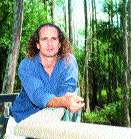 For
Magical Kids For
Magical Kids
Since moving to Ft. Myers in August, Milo Gralnick, 36, is spending his
time and energy as director of the newly created Magical Kids Studio.
It’s a nonprofit, after-school arts program for low-income children
in kindergarten through second grade. Tuition and transportation are free.
Magical Kids Studio, at 10851 Bromley Lane in
Ft. Myers, is on ranch property owned by Gralnick’s father and stepmother,
Marvin and Helene Gralnick, who founded Chico’s women’s clothing
stores. The studio occupies several buildings and is licensed by Florida’s
Depart-ment of Children and Families.
Milo Gralnick is excited about offering ceramics
and painting programs at Magical Kids Studio. He hopes in the future to
add film, video, theater arts, and music, and maybe expand to include
elementary-aged children. (For more information, contact Milo Gralnick
at 239/418-1079.)
The entire project is right up his alley: Gralnick
holds a master’s degree in education from Washington University in
St. Louis and is certified to teach art. For several years, he worked
with second-graders in the inner city of St. Louis and also taught kindergartners
in a suburban private school.
– Libby Grimm
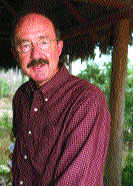 Going
Green at FGCU Going
Green at FGCU
As an undergraduate majoring in anthropology and zoology, John Fitch assumed
his career would focus on theoretical research. Life had other plans,
however, and now Fitch, an associate professor of environmental studies
at Florida Gulf Coast University, finds himself leading the charge to
shape the school into a model of environmental stewardship and sustainability.
A founding faculty member of FGCU, Fitch came
to the university following stints as president and chief executive officer
of the Conservancy of Southwest Florida, as chief scientist for the Massachusetts
Audubon Society and as a faculty fellow in the Executive Office of the
President when then-President Jimmy Carter was crafting the Global 2000
Report. The experiences helped him realize how much humans impact their
environments and how they can, in fact, learn to tread lightly.
“I really like Churchill’s line, that
we shape our dwellings and our dwellings shape our lives,” Fitch
says. “That’s the crux of the whole matter. We can take actions
to ensure both the quality of our lives and the continuation of basic
environmental resources for future generations. We’re not doing nearly
as much as we can and should be doing.”
Fitch is doing what he can to guide FGCU into
doing more. He was instrumental in establishing an environmental literacy
course, which all students must complete before graduation. Last year
he headed an environmental task force, resulting in the creation of an
environmental stewardship advisory board (made up of students, faculty
and staff). He also serves as the university’s director of the Institute
for Sustainability and as project director for the Green Building Project.
The latter is an ambitious project to construct
an educational center incorporating various environmentally friendly and
economically feasible features—things like water conservation, hurricane
protection, solar water heating, and recycling.
“We want to be very user friendly,”
Fitch says, “a place where prospective home buyers can go with their
builders or architects. We want to be a catalyst for home building in
Southwest Florida, a demonstration of what can be done and where you can
find it.”
Groundbreaking for the project was set for Earth
Day this year, and Fitch hopes the building will be complete by Earth
Day 2003. He is currently looking for monetary and supply donations, as
well as interested volunteers. Together, he explains, we can make a sustainable
future a reality for us all.
(To learn more about the Green Building Project
or get involved, call project assistant Susan Fohs at 239/590-7197.)
– Janina Birtolo
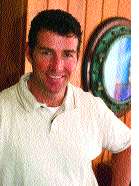 Racing
Champion Racing
Champion
These days, Thomas Stevens and his wife Linda own and operate Stevens
Family Chiropractic on Sanibel, where they also live. But motorcycle racing
fans still recognize him as one of the world’s premier racers.
“My father rode street bikes and I started
riding with him as a little kid,” Stevens says. He got his first
bike when he was 7, “much to the dismay of my mom,” he recalls,
and he was racing by the time he was 11.
In 1980, just after his father passed away, Stevens
won the Maryland State Championship, but by 1981 he had stopped racing
altogether.
After he graduated from high school, he moved
with his mother to Cape Coral. He was working and goofing off and, in
spite of all those years of disciplined racing on Sundays, he let his
dreams slide.
During a shift as pizza cook, he had an epiphany:
“If I don’t race again and chase my racing dreams, I’ll
regret it.” By 1984 he was racing again.
A year later, he moved to Sanibel and shared a
house with islander and fellow racer Mark McQuade. “I became an amateur
and traveled with Mark, ’cause he had a van. Almost every weekend,
we went to a different club race,” he says.
“I needed to work at a place where they let
me go racing,” so Stevens took a job at Ft. Myers Cycle. “I’d
get a good deal on bikes and parts.”
A first, his good deals were offset by bad luck.
A shop in Naples let Stevens sign for a motorcycle instead of paying for
it. Soon after, he totaled it. His mom, who had developed a change of
heart about racing, put the next bike on her credit card. Stevens was
now up to his neck in debt for two bikes, but never wavered in his belief
he could be a professional, despite those who tried to burst his bubble.
A slew of titles followed. Stevens won two classes
in the Amateur National Championship of 1986, then came in second in the
nation in the 600 SuperSport series 1987. By 1988, three-time World Champion
Kenny Roberts asked him to join his racing team as a pro. Stevens finished
second in the nation that year.
Yamaha came back into the premier class with a
750 Superbike and Stevens tested it at Daytona. After coming within a
half-second of breaking the track record the first time he rode the bike,
Stevens landed a Yamaha contract.
In 1990 the American Motorcyclist Association
voted Stevens the Superbike Rookie of the Year. He capped his award with
a 1991 National Championship title for Yamaha, still the only AMA Superbike
Championship win the company has had in 25 years.
Stevens was under contract to Kawasaki long enough
to hand them a second-place finish at the national level, then Suzuki
came calling and “they had a ton of money,” admits Stevens.
He spent the next three years riding for Suzuki and “making more
money than I could ever even imagine riding a motorcycle.”
When Ducati approached him in 1997, Stevens signed,
but he soon realized it was time to retire. “I had had a 10-year
career,” he explains. “I never spent a night in the hospital,
although I had lost three teammates. I was 34 years old and I knew it
was time for me to go.”
Thomas Stevens went out on top and now helps Linda, a chiropractor, run
their Sanibel-based business, Stevens Family Chiropractic. You can still
see his photo on posters in motorcycle shops across the country.
As for the naysayers of the past, “They said
‘You’re not going to do it. Only a handful of guys make it and
you’re not going to make it,’ ” recalls Stevens. “They
didn’t know what was in my heart. I got to serve up some humble pie.”
– Libby Boren McMillan
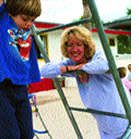 Attending
to Preschool Attending
to Preschool
When Susan Peck enrolled her two young children in the Children’s
Center of the Islands in 1997, little did she know that two years later
she’d become director of the Sanibel-based, nonprofit preschool.
“It’s been an ideal match,” Peck
says happily.
Her husband, Michael Gomez, took early retirement in 1997 and the family
moved from New Jersey to live year-round in their Sanibel house. “At
first I was staying home with my children, but after they started at the
Children’s Center, I began teaching music there on a volunteer basis
for about a year.”
Peck holds a bachelor’s degree in music education
and taught music for a few years in New Jersey before “making a complete
career switch by going into business.” She spent a decade in various
capacities, including working as a consultant in Manhattan for William
M. Mercer, an international, human relations consulting firm.
Peck did not initially apply for the Children’s
Center director position, “but some parents encouraged me. I went
through the whole process and was hired.”
Now she reports, “I’m thrilled how things
are going. With 60 children ages 2 to 5, enrollment has almost doubled
since 1999. I’ve worked to make the school more accessible. We’ve
expanded our scholarship program and our hours. We have a full-time Spanish
teacher and I still teach music two days a week. I purposely kept my hand
in that!”
– Libby Grimm
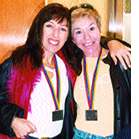 Making
Strides Against Breast Cancer Making
Strides Against Breast Cancer
Who were those exuberant women wearing decorated bras in November’s
New York Marathon? Islanders Mary Irving and Barb Silvers joined their
friend Nina Barough, all walking in uniquely sensational bras, in the
name of breast cancer research.
Barough, a longtime visitor to the islands, is founder of the very successful
fund-raising group, Walk The Walk. It began on a whim, with 13 highly
visible bra-clad women walking the New York Marathon. They got a lot of
attention and raised a lot of money. Barough was adamant the funds be
given to breast cancer research, although she knew nothing about it. She
was leading a full life as a photo stylist for catalog shoots. All that
changed soon after, when Barough herself was diagnosed.
“Overnight, I had to give up my work, get treatment and surgery,”
she says. “My friends did the London Marathon to support me. It kept
me focused and positive during something very traumatic.”
Barough recovered but left her job; her new idea
now had legs of its own. She continued to organize walking women, scraping
by on a meager salary and the help of friends. Playtex UK eventually gave
Barough office space for two years, allowing her organization to grow.
In 1999, Walk The Walk was registered as an official charity and it has
since grown from 13 women to about 20,000. In September, when Prince Charles
invited organization members to his Highgrove country estate, WTW used
the occasion to present a million pounds to charity.
The sheer size of the group gave birth to its own event, Moonwalk, which
raised a million pounds this past May and got worldwide coverage.
“We’re sort of taking part in all these
different events all the time,” says Barough. “We’ve had
girls skydiving in their bras; this year we’re going to the Peru
Inca Trail.”
Barough’s island pals, Irving and Silvers, often join her and have
walked in both London and New York. For more information, visit the Web
site at www.WalkTheWalk.org.
– Libby Boren McMillan
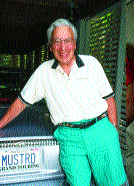 Spice
of Life Spice
of Life
Did you know that most of the world’s mustard seed comes from the
Canadian prairie provinces?
A chat with Captiva homeowner Ron Kramer will
test just how much you know about the ingredients of a common condiment.
Kramer is the owner of G.S. Dunn, global supplier of dry mustard products
and Canada’s only dry mustard miller. More than 45 countries on six
continents purchase products from the company, which has been in business
since 1867.
Kramer got into the food ingredient industry when
his accountant brought the opportunity to his attention. “I was happily
retired,” bemoans a joking Kramer, who says that, prior to purchasing
Dunn in 1988, his “only experience with food was eating it.”
His humble nature belies his success. G.S. Dunn is now the premier supplier
of mustard products—including mustard flours, ground mustard, brans,
and deactivated mustard—to the world.
“Very little mustard flour goes into mustard,”
explains Kramer. “It goes into mayonnaise, salad dressing, barbecue
sauce. A lot of it’s also used in the meat industry as a protein
supplement in hot dogs and sausage.” Who knew?
As chief executive officer, Kramer oversees production,
manufacturing, and personnel, and he periodically makes sales calls. But
anyone who knows him well knows where he’d rather be: on the water.
Kramer keeps a sailing yacht on Captiva, where he and wife Helen spend
winters away from their primary home in Toronto. On sunny, breezy days,
one will most likely find him plying the waters of Pine Island Sound.
Cooks and trivia buffs will appreciate a visit
to www.gsdunn.com, which is a font of mustard facts, history, recipes,
and more.
– Libby Boren McMillan
|

